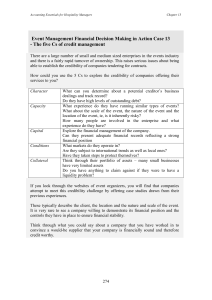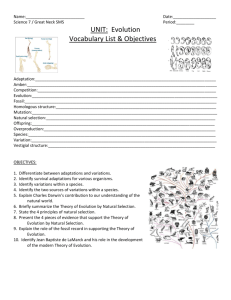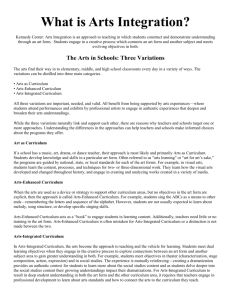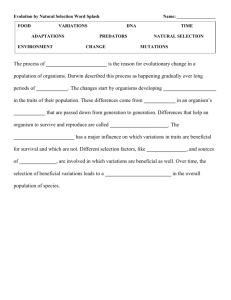Variable
advertisement
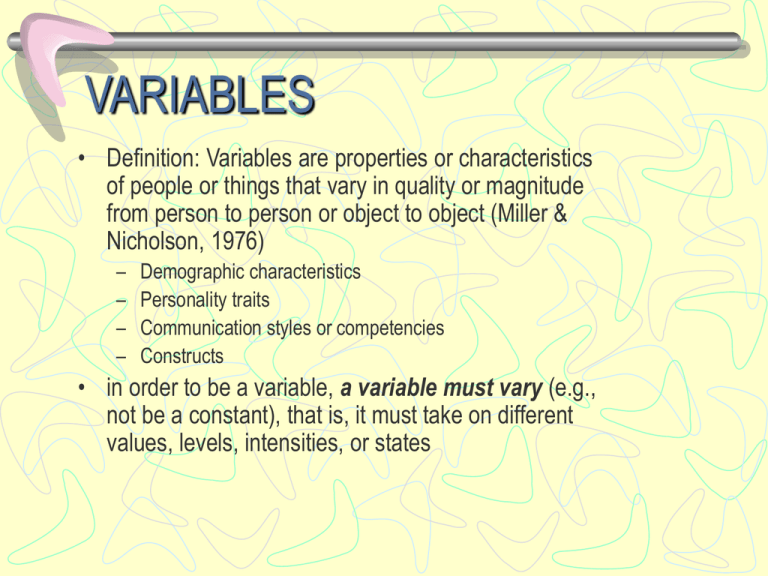
VARIABLES • Definition: Variables are properties or characteristics of people or things that vary in quality or magnitude from person to person or object to object (Miller & Nicholson, 1976) – – – – Demographic characteristics Personality traits Communication styles or competencies Constructs • in order to be a variable, a variable must vary (e.g., not be a constant), that is, it must take on different values, levels, intensities, or states Definitions • Variable: “any entity that can take on a variety of different values” (Wrench et al, 2008, p. 104) – gender – self-esteem – managerial style – stuttering severity • attributes, values, and levels are the variations in a variable – Attribute: political party: – Value: Democrat, Republican, Independent, etc. – Attribute: Self-esteem – Level: High, Medium, Low independent variable • the variable that is manipulated either by the researcher or by nature or circumstance • independent variables are also called “stimulus” “input” or “predictor” variables • analogous to the “cause” in a cause-effect relationship “operationalization” of the independent variable • Operationalization: translating an abstract concept into a tangible, observable form in an experiment • Operationalizations can include: – variations in stimulus conditions (public schools versus home schooling) – variations in levels or degrees (mild vs. moderate vs. strong fear appeals) – variations based on standardized scales or diagnostic instruments (low vs. high self esteem scores) – variations in “intact” or “self-selected” groups (smokers vs. non-smokers) varieties and types of variables • Discrete variables – Nominal variables: distinct, mutually exclusive categories • religions; Christians, Muslims, Jews, etc. • occupations; truck driver, teacher, engineer • marital status; single, married, divorced – Concrete versus abstract variables • concrete; relatively fixed, unchanging – biological sex – ethnicity • abstract; dynamic, transitory – mood, emotion – occupation – Dichotomous variables: • true/false, female/male, democrat/republican – Ordered variables: mutually exclusive categories, but with an order, sequence, or hierarchy • fall, winter, summer, spring • K-6, junior high, high school, college varieties and types of variables-continued • Continuous variables: include constant increments or gradations, which can be arithmetically compared and contrasted – IQ scores – self-esteem scores – age – heart rate, blood pressure – number of gestures Unit of analysis • • Definition: The specific entity being examined – individual; self esteem, fluency – dyad: self disclosure, touch – group: roles, norms – Organization: communication networks, upward-downward influence – Culture: individualism vs. collectivism What constitutes a specific score or measure on the outcome variable? – marital satisfaction? – one row of data in SPSS • • Ecological fallacy: drawing conclusions about individuals based on group data committing a “sweeping generalization” about participants in a research study – individualism/collectivism – all southerners are bigots operationalization • definition: the specific steps or procedures required to translate an abstract concept into a concrete, testable variable – example: high versus low self-esteem (split-half or top vs. bottom third?) – example: on-line versus traditional classroom (how much e-learning constitutes an “on-line” class?) examples of operationalizations • credibility (high versus low) • culture/ethnicity (self-report) • type of speech therapy (inclinic vs. at school, vs. at home) • compliance-gaining strategy preferences (positive versus negative, self-benefit versus other benefit) • “powerless” language style • fear appeals (mild, moderate, strong) • food server touch versus no touch dependent variable • a variable that is observed or measured, and that is influenced or changed by the independent variable • dependent variables are also known as “response” or “output” or “criterion” variables • analogous to the “effect” in a cause-effect relationship confounding variable • also known as extraneous variables or intervening variables • confounding variables “muddy the waters” • alternate causal factors or contributory factors which unintentionally influence the results of an experiment, but aren’t the subject of the study mediating variable • a.k.a. moderating, intervening, intermediary, or mediating variables • a 2nd or 3rd variable that can increase or decrease the relationship between an independent and a dependent variable. • for example, whether listeners are persuaded more by the quality or quantity of arguments is moderated by their degree of involvement in an issue. interchangeability of independent and dependent variables • The same concept or construct could serve as the independent variable in one investigation, and the dependent in another. • example: “source credibility” – as an independent variable; RQ: Does source credibility (low versus high) have a significant effect on attitude change? – As a dependent variable; RQ: Does the amount of evidence contained in a speech affect listeners’ perceptions of the source’s credibility? • example: “fetal alcohol syndrome” (FAS) – As an independent variable: RQ: Does severity of FAS correlate positively with language delay in infants? – As a dependent variable: RQ: Does the amount of maternal alcohol use correlate positively with the severity of FAS in infancy? Relationships among variables • Differences – Differences in kind, degree • Relationships (correlations) – Positive correlation – Negative correlation – No or neutral correlation
